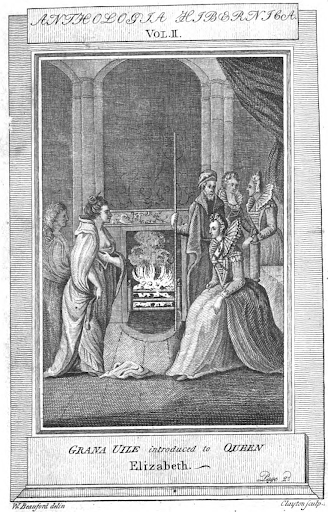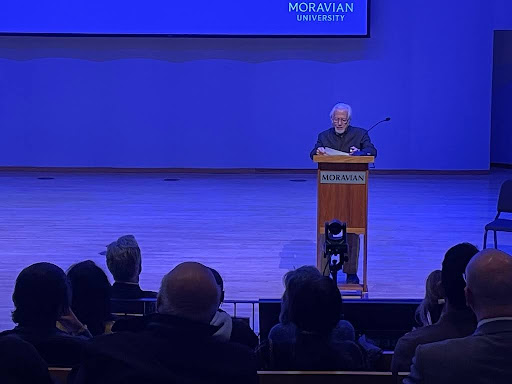
In 1530, a daughter was born at Clare Island, modern-day Co. Mayo, to the chieftain of the Ó Máille (O’Malley) clan, Eóghan “Dubh Dara” Ó Máille (Owen “Duv Dara” Oh Mah+lee – Owen “Black Oak” O’Malley). Gráinne Ní Mháille (Graw+Nee+uh Nee Wall+EE), or Grace O’Malley in English, would become a hero of legend, her name inspiring thousands, centuries later, to rise up and reclaim their nation and culture.
She was politically powerful and determined not to let anyone define who she was or should be.
Ireland was a tumultuous place when Gráinne lived there. Her clan had lived off the seas for generations, their main conflicts being with other neighboring clans, but things were changing.
By about age 10, her father saw a spirit of leadership and determination after she chopped off her hair, earning her the nickname “Gráinne Mhaol” (Graw+Nee+Uh Whale), Anglicized as Granuaile, meaning “Gráinne the Bald.”
Gráinne had been told by her father she was not allowed to join him on trading ventures, but in her stubbornness, she proceeded to dress like a boy and stowed away on his ship, only revealing herself when they were too far from Ireland to turn back.
She ultimately saved his life by ambushing an English soldier among those who had come to attack the O’Malley fleet, and who was about to attack her father. She took him down and earned her place at sea.
When Gráinne was 16, the reach England had over Ireland was quickly growing, and her father granted her the role of commander of their fleet of ships.
At this young age, she commanded the fleet, wielding it as a tool to control the ships flying the flag of the British Crown. She imposed a tax on the use of the waters of the O’Malley territory. Anyone who sailed into her territory under the British flag was subject to pay directly to her.
Should they refuse to pay, and often they did because the English believed that all the seas were the property of The Crown, she would take the small fishing vessels out with a band of her best men and attack. They would take everything on board, tie up the crew, and leave them to drift before slipping back into the maze of rocky inlets that make up Clew Bay.
This act earned her the title, officially by Queen Elizabeth I, of “The Queen of Thieves and Murderers at Sea,” or in shorter terms, “Pirate Queen.”
Additionally, at 16, Gráinne was married for the first time, as was custom, though this union lasted less than a decade, for her husband, Domhnall Ó Flathbheartaigh (Doh+Null Oh Flah+ver+Ar+Tee), was hot-headed, rash, and rather fond of combat. As such, he often stirred up fights with the neighboring clans. This would ultimately be his demise; however, during their marriage, they had three children.
The eldest, Eóghan, named for his grandfather, was noted as being a gentle and deeply hospitable man. The second, Meadhbh (Meave) was very much like her mother. Finally, Murrough was as hot-headed as his father and incredibly cruel to his mother and sister simply because they were women. Gráinne raised these three children while building up her sea empire from her husband’s castle of Aughnanure (Aw+Nuh+Nor).
Following the death of Domhnall, Gráinne would remarry, this time to a man whom she genuinely loved, although she wasn’t entirely attached to the idea of remaining formally married. Risdeard “an Iarainn” Bourke (Rish+Dard Awn EE+Ran Burke), Richard “In Iron” Burke, was her true match.
Even despite only being formally married for just under a year, the two were very much in love and would remain together until his natural death. She was even formally referred to as the Lady Burke.
The two would have a son, who was born at sea while Gráinne was returning home from trading in Spain. The boy was named Tibbot, or Toby “of the Ships.” That, however, is a story for another day.
The brewing troubles in Clew Bay were fairly controlled while Sir Henry Sidney was the English Governor of Connacht. But this containment would quickly change upon Sidney’s replacement with Sir Richard Bingham.
While Sidney was largely compliant with Gráinne, Bingham was cruel and determined to not only get rid of Gráinne but to destroy her and do so in the most brutal way he could think of.
He went after Gráinne’s eldest, tricking Eóghan by using his hospitality and kindness against him. Bingham’s men captured him, slaughtered his entire family, and brutally tortured him to death. It was reported by Bingham that there were some 12 wounds inflicted upon him before he died.
Bingham justified this brutality by painting Eóghan as a coward who tried to flee when confronted. Gráinne, who by this point had been fighting Bingham for decades, was completely torn apart upon receiving the news of her beloved eldest’s murder.
Gráinne herself was eventually captured by Bingham under a similar trap that had claimed her son. She spent years in prison at Dublin Castle, sitting in the shadow of a specially-made gallows. She was rescued by her loyal men who knew that her life and her leadership were more valuable than theirs. As such, they traded places with her, fulfilling the sentence in her place and allowing her to return home.
However, despite being home, she found her lands had been dispossessed and her fleets wrecked upon the shores. Bingham’s treatment of her people was so cruel that some of his men even reported how sickened they were to have to enforce it. Her people were starving, her family suffering. Further, Bingham had captured her youngest child, Toby, and his life was now on the line. She couldn’t lose another child.
Gráinne went straight to the source, seeing no other option left for her. She began to petition Elizabeth I directly, begging for an audience.
Finally, after years of these back-and-forth letters, Gráinne was granted permission to travel to England to meet with The Queen.

In July 1593, the meeting of The Virgin Queen and The Pirate Queen occurred at Greenwich. What exactly was said is unknown; however, the record in the English state papers indicates that Gráinne and The Queen came to an agreement. Gráinne would receive her lands and her son back, as well as protection from The Queen herself, for the rest of her life. In turn, Gráinne would serve in the English Navy and never again go against The Crown. Sir Bingham was then removed from office and stripped of his title for his cruelty.
Gráinne upheld her end of the deal, at least on the surface. Reports from the last decade of Gráinne’s life, following the famed meeting at Greenwich, indicate that she never truly gave up her fight against the British overtake of Ireland. One key report comes from the Tyrone Rebellion, which would result in a forced mass removal and exodus of several Irish lords, known as “The Flight of the Earls.” This report indicates a blockade at the mouth of the River Shannon that served both to prevent usage of the river by the British and to ferry supplies to the rebels in the north. The blockade was made up of Gráinne’s fleet.
Following her death in 1603, her legacy lived on through her descendants, stories, and legends. Her name would be among the few that would inspire Ireland to rise up during the Irish Independence Movement in the late 19th and early 20th centuries, taking on a heroic role as the personified spirit of Ireland, someone worth fighting for and with.
Gráinne Ní Mháille would become a name of inspiration in the Abbey Theatre play The Rising of the Moon, where a young escaped prisoner encounters a police officer who is of Irish birth, and tries to persuade him to stop serving the British and join the cause of Irish Independence, by singing about good ole “Granuaile.”
Her name would be sung into battle during the Irish War of Independence (1919-1921) in a song called “Oró, Sé Do Bheatha ‘Bhaile” (Oh+row Shay Do Vah+uh Wall+yuh), “Oh, you’re welcome home” in English, a song which recounts Gráinne’s time in captivity and her own efforts in “routing the foreigners.”
The life of Ireland’s Pirate Queen is more involved and complex than there is time to fully relay here; however, she should be recognized in history for what she fought for and believed in, as well as for the role she played centuries following her death, in the war that finally made Ireland free.







